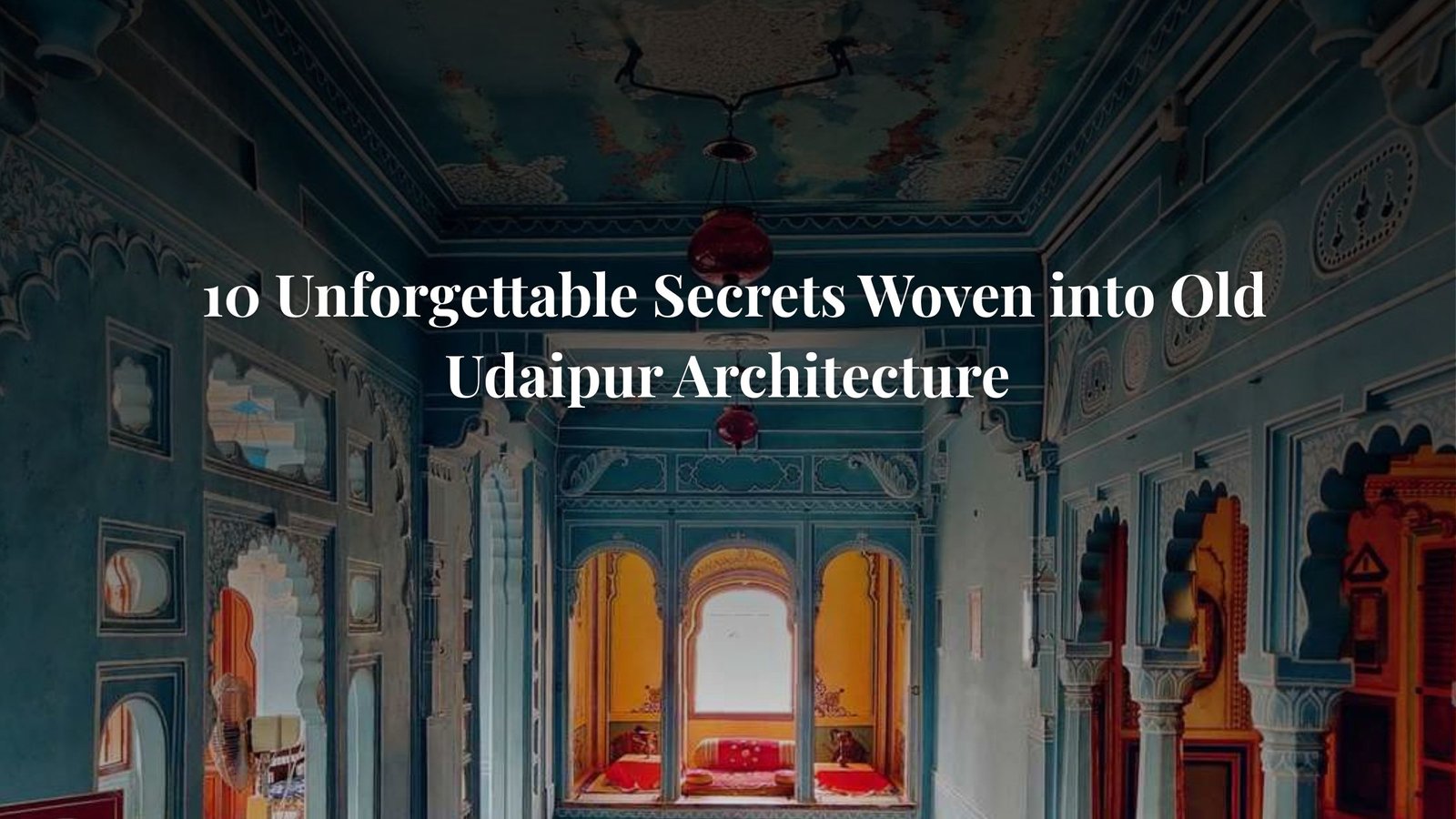Discover the Genius Behind the White City’s Timeless Design
Udaipur, the “City of Lakes,” has always been synonymous with royal grandeur, shimmering palaces, and romantic vistas. Yet, to truly understand the soul of this breathtaking city, one must look past the majestic glow of the Lake Palace and delve into the labyrinthine alleys of the old town. This is where the real story of Old Udaipur Architecture is written—not in grand pronouncements, but in the intricate stone carvings, the ingenious ventilation systems, and the humbling beauty of a thousand tiny details. Our architectural walk through these historic streets reveals not just structures, but ten deep-rooted secrets of sustainable and stylish Mewar design that make this city truly unforgettable.
For those who have walked the narrow, winding pathways near Jagdish Chowk or Gangaur Ghat, the sheer density of history is palpable. Every turn unveils a new tableau: a fresco-painted wall, a heavy wooden door studded with brass, or a flash of color from a textile shop tucked beneath an ancient arch. This isn’t just picturesque scenery; it’s a living museum of Old Udaipur Architecture, a style that perfectly harmonizes with the desert climate and the Rajput culture. Prepare to step back in time and uncover the genius threads of design that weave the city’s legacy.
1. The Power of the Jharokha: An Ancient Viewpoint
The Jharokha, or overhanging enclosed balcony, is arguably the most recognizable element of Rajasthani and, specifically, Old Udaipur Architecture. It’s more than just a decorative feature; it’s a testament to architectural intelligence and social custom.
These delicate, stone-latticed windows project from the facades of havelis and palaces. Historically, they served two crucial functions: first, they allowed royal and noble women to observe street life and public ceremonies unseen, respecting the purdah tradition. Second, and architecturally brilliant, the intricate jali (lattice) work acted as a phenomenal passive cooling system. It filtered harsh sunlight, reduced heat gain, and channeled cool breezes into the interiors, a sustainable air-conditioning system long before electricity. Today, the Jharokha remains a signature of Old Udaipur Architecture, turning residential homes into pieces of art and offering residents a private window onto the bustling world below. The repetition of this single design element throughout the city creates a visual harmony that is breathtaking.
2. Haveli Heritage: The Courtyard’s Cooling Heart
The Haveli—the traditional townhouse of prosperous merchants and noble families—is a masterclass in vernacular Old Udaipur Architecture. Its structure is defined by the aangan or central courtyard, a space that is the functional and social heart of the building.
The courtyards, often open to the sky, are essential for climate control. They employ the “stack effect,” where warm air rises through the courtyard and escapes, drawing cooler air in from the outside streets or lower levels. This natural ventilation is a prime example of the sustainable genius of Old Udaipur Architecture. Furthermore, the courtyard provided light, a safe space for women’s social gatherings (zenana), and a venue for family rituals. Walking through the narrow streets, look closely at the entrances; the seemingly modest doorways often conceal a sprawling, multi-courtyard Haveli—a secret world of domestic architectural bliss.
3. The Chhatri Canopy: Stone Symbols of Glory
Dotted across the rooftops of havelis, and prominently featured in palaces and lakeside cremation grounds (like the Ahar Cenotaphs), the elegant, dome-shaped pavilions known as Chhatris are enduring symbols of Rajput glory. While many function as memorials or cenotaphs, their architectural impact on the city’s skyline is profound.
The Chhatri adds a layer of visual texture and height variation to the flat roofs of Old Udaipur Architecture. They provide essential shade and a structural counterpoint to the city’s larger monuments. Their form—a dome supported by small pillars—is highly recognizable and is a stylistic motif that has been carried forward into modern Udaipur’s rooftop restaurants and hotels, maintaining the city’s architectural continuity. Spotting these small, beautiful structures against the backdrop of the Aravalli hills is a truly breathtaking sight.
4. Jali Screens: The Art of Filtration
The stone lattice or perforated screen, the Jali, is an element that speaks volumes about the Mewar architects’ understanding of local climate and aesthetics. Unlike the grand, solid statements of European castles, much of Old Udaipur Architecture is designed to be permeable.
The Jali serves a triple purpose: reducing the intensity of the harsh Rajasthani sun, allowing for controlled cross-ventilation, and providing a veil of privacy. The patterns themselves are intricate works of stone craftsmanship, creating mesmerizing geometric shadows that shift and stretch across the interiors throughout the day—a constantly moving, living artwork. This deliberate use of pattern and perforation is the genius of Old Udaipur Architecture, proving that beauty and function can be one.
5. The Whitewashed Canvas: A Defense Against the Sun
The overwhelming color of the old city—the bright, reflective whitewash on most residential and commercial buildings—is not a random aesthetic choice, but another deliberate climatic adaptation in Old Udaipur Architecture.
In a region where temperatures can soar, a reflective, light-colored surface is the most effective way to repel heat. The lime-based paint and plaster, often tinted blue in some areas, help keep the interiors of the Havelis remarkably cool. This uniform palette also contributes to the “White City” nickname and enhances the drama of the colorful local life, from the vibrant saris to the rich hues of the traditional miniature paintings sold in the streets. The choice of white is a foundational architectural strategy that has defined the city’s visual brand for centuries.
6. The Jagdish Temple: A Statement in Stone
While wandering the narrower lanes of Old Udaipur Architecture, the massive Jagdish Temple suddenly looms, a towering masterpiece of the Indo-Aryan style. Built in 1651, it dominates the main chowk near the City Palace and serves as a powerful focal point for the surrounding streetscape.
Its high pyramidal spire (shikhara), elaborate carvings depicting gods, goddesses, and musicians, and monumental scale contrast sharply with the modest size of the residential Havelis around it. The temple’s construction used a significant amount of white marble and features a stunning black stone image of Vishnu. Its presence demonstrates the deep spiritual underpinning of Old Udaipur Architecture and its commitment to monumental religious art, providing a necessary counterpoint to the secular domestic design.
7. The Negative Space: Winding, Narrow Alleys
One of the most powerful yet often overlooked elements of the Old Udaipur Architecture experience is the street itself. The streets are deliberately narrow, winding, and often hilly, forming a dense and irregular pattern.
This density is a brilliant, passive urban planning strategy. The closeness of the buildings provides shade for the streets, reducing sun exposure on the lower walls and keeping the ground level cooler. The convoluted path also slows down the wind, increasing humidity and comfort in an otherwise arid climate. This “negative space” of the street plan fosters community, creating sheltered, walkable, and vibrant corridors that are a far cry from modern, wide, concrete roads. Walking these narrow lanes offers a truly unforgettable immersion into the living, breathing history of Old Udaipur Architecture.
8. Rajput-Mughal Fusion: A Remarkable Blend
The key structures in Old Udaipur Architecture, especially the City Palace complex, showcase a remarkable synthesis of Rajput (local) and Mughal (imperial) styles. This architectural dialogue is a subtle secret that defines the city’s palaces and larger Havelis.
Look for the Rajput elements: the aforementioned Jharokhas and Chhatris, the tiered roofs, and the use of white lime plaster. The Mughal influence introduces elements like the cusped or scalloped arches, inlaid marble work (pietra dura), and expansive, organized gardens. This fusion wasn’t accidental; it was a reflection of the political and cultural exchanges between the Mewar kingdom and the Mughal empire, creating a unique, opulent, and highly sophisticated form of Old Udaipur Architecture that can be admired in the grand structures visible from the street.
9. Ghats: Architecture Interfacing with Water
The Ghats—the wide, stepped platforms leading down to Lake Pichola—represent a fusion of architecture and nature that is central to the city’s identity. Places like Gangaur Ghat are an extension of Old Udaipur Architecture into the water body itself.
The stone work of the Ghats provides a stable, communal space for religious rituals, bathing, and social interaction. They are designed to manage the fluctuating water levels of the lake while offering a stunning, framed view of the Lake Palace and the City Palace complex. The deliberate, sturdy construction of these Ghats showcases the Mewar engineers’ genius in managing their most precious resource: water. The transition from the dense street to the open space of the Ghat is a dramatic, breathtaking experience.
10. The Terraces: Elevated Living Spaces
Finally, a look upwards reveals the private lives of the city: the extensive rooftop terraces. Given the density of the narrow streets, these terraces were, and still are, essential communal and private spaces, another hidden secret of Old Udaipur Architecture.
They function as open-air living rooms, for sleeping under the stars during summer, drying laundry, flying kites, and socialising. They provide a connection to the sky and offer the residents spectacular, privileged views of the city’s famous architecture that are simply unforgettable.
The Unforgettable Legacy of Old Udaipur Architecture
Walking the streets of Old Udaipur is to experience a masterclass in urban planning and climate-responsive design. The 10 secrets unveiled—from the passive cooling of the Jharokhas and Havelis to the powerful spiritual geometry of the Jagdish Temple—demonstrate a unified vision.
This isn’t merely a collection of beautiful old buildings; it’s a functioning, ingenious architectural ecosystem. The collective impact of these design elements creates an atmosphere that is truly unforgettable. So, as you plan your next trip, remember that the true magic of Udaipur is found not just in its palaces, but in the intricate, history-laden streets where the enduring genius of Old Udaipur Architecture still thrives, whispering tales of Rajput royalty, merchant prosperity, and a timeless, breathtaking way of life.



